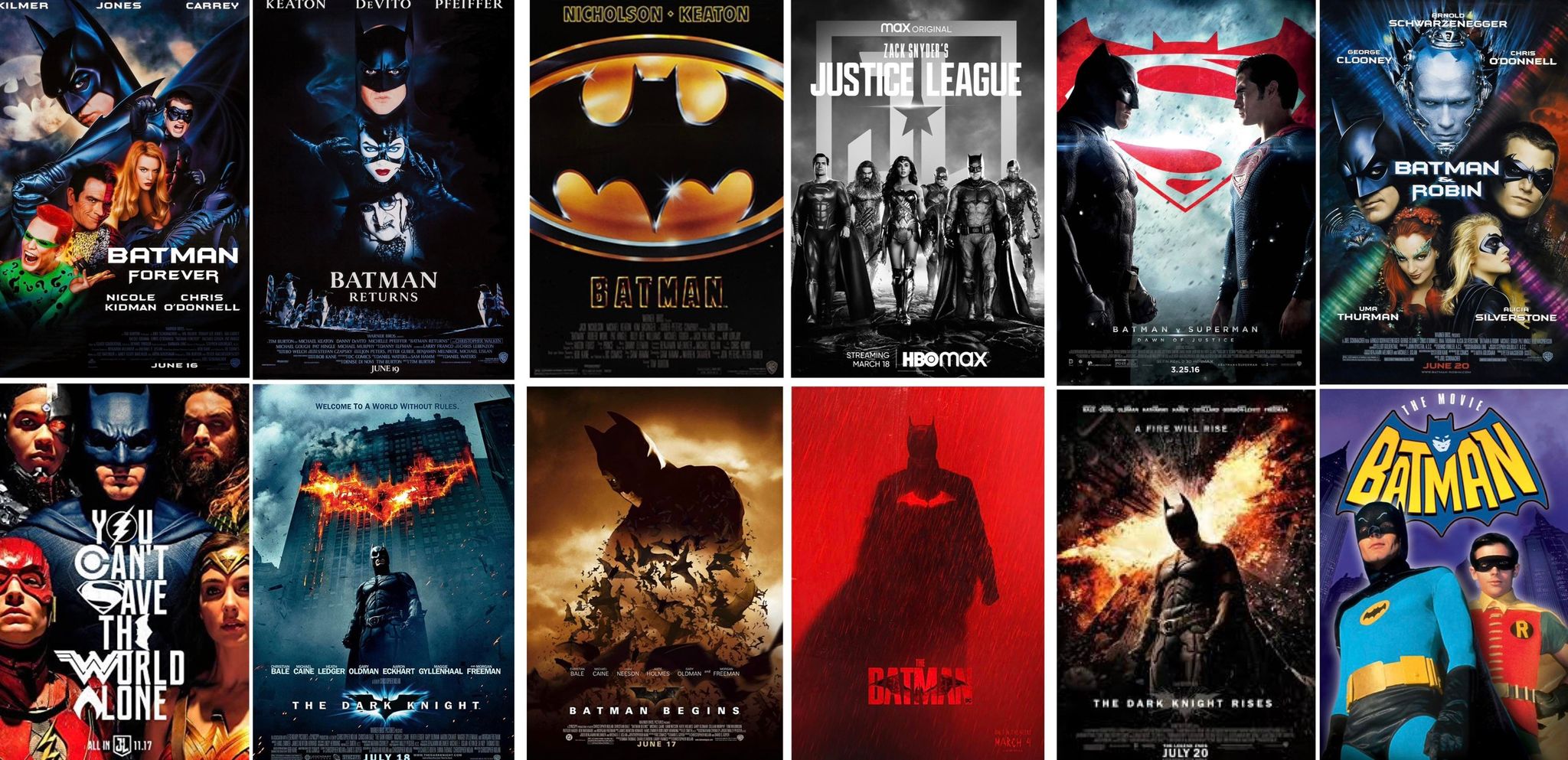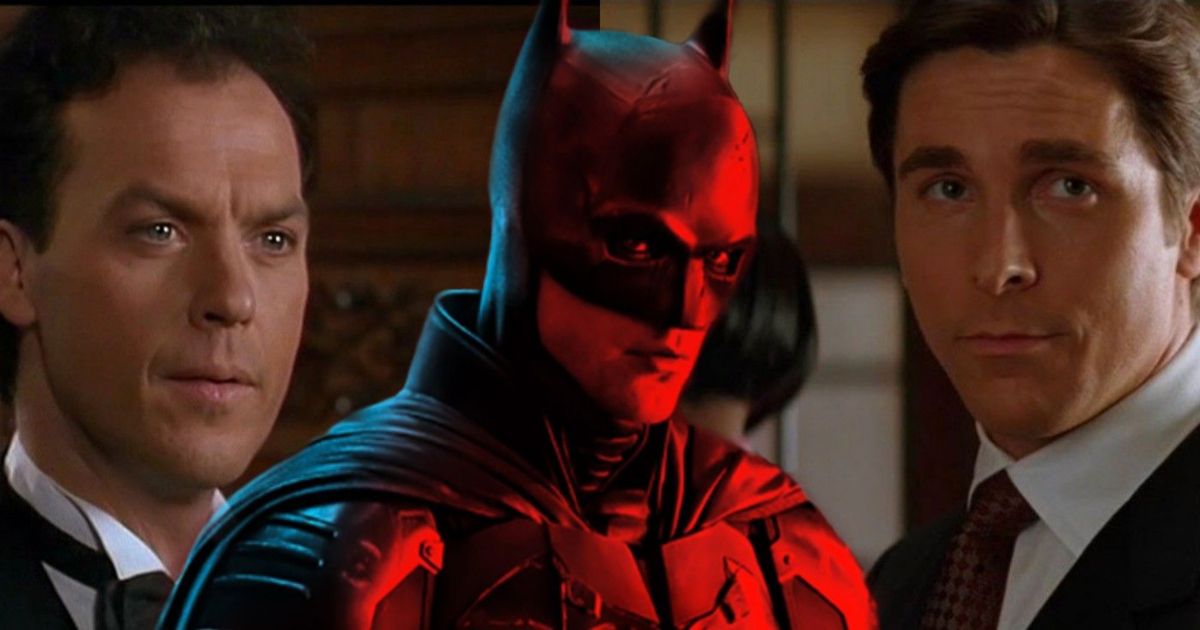Batman Movies In Order: The Complete Filmography Timeline + Guide
Can one ever truly untangle the bat-web of cinema releases? When considering the multifaceted legacy of the Dark Knight, it is essential to approach the filmography as an evolving tapestry, not a rigid, chronological mandate.
Navigating the Batman film saga can indeed feel like deciphering a riddle wrapped in an enigma, especially with the various reboots, shared universes, and standalone narratives. Below is a roadmap outlining the theatrical release sequence of Batman films, designed to provide some clarity amidst the Bat-Signal-induced haze.
The Batman (1989)
Batman Returns (1992)
Batman Forever (1995)
Batman & Robin (1997)
Batman Begins (2005)
The Dark Knight (2008)
The Dark Knight Rises (2012)
Batman v Superman: Dawn of Justice (2016)
Justice League (2017)
The Batman (2022)
- Loving Aunt Free Episodes Online Download Is It Legit
- Vegamovies4u Your Guide To Free Movies Amp Tv Shows Is It Safe
Ultimately, the enjoyment of Batman's cinematic adventures lies in embracing the diverse interpretations. Each film stands as its own unique vision, contributing to the broader, richer mythos of Gotham's guardian.
| Category | Details |
|---|---|
| Character Name | Bruce Wayne / Batman |
| Alter Ego | Batman |
| First Appearance (Comics) | Detective Comics #27 (May 1939) |
| Creators | Bob Kane, Bill Finger |
| Skills & Abilities |
|
| Base of Operations | Wayne Manor, Gotham City |
| Allies |
|
| Enemies |
|
| Movie Appearances |
|
| Official Website | DC Comics - Batman |
Understanding the order of the Batman films provides invaluable insight. It allows enthusiasts to trace the evolution of the character, place each film within a larger context, and fully appreciate the individual artistic choices of various filmmakers.
Deconstructing the film sequence highlights pivotal aspects. These range from premiere dates and directorial visions to the actors' portrayals of the hero and the varying stylistic approaches taken across the adaptations.
- The Truth About Taylor Swift Joi Ethics Amp Dangers Exposed
- Breaking Are Greg Gutfeld And Jesse Watters Really Friends Find Out
The order in which these films have unfolded has undeniably molded both the Caped Crusader's public image and his sustained appeal. While early interpretations cemented Batman as a cultural touchstone, more recent productions have reimagined him for contemporary audiences.
The order of the Batman films provides a framework. This framework enables a more profound comprehension of the characters ongoing saga and the diverse elements that have contributed to his enduring mythos.
The release dates of the Batman features have shaped the Dark Knight's path. From the campy 1960s television series to the stark realism of the Christopher Nolan trilogy, these dates punctuate significant shifts in tone, style, and thematic depth.
The calendar dates on which Gotham has graced our screens are more than simple markers of time. They are milestones that track Batmans ascent from a colorful crime fighter to a psychologically complex figure grappling with existential crises.
The original 1960s television series acted as an ambassador, presenting Batman to a broad audience and establishing his place in the cultural consciousness. Its whimsical tone and cast of larger-than-life villains veered sharply away from the somber atmosphere of the comics, yet its success was undeniable.
Tim Burtons 1989 cinematic offering ushered in a new era of Batman. His vision introduced a darker, more visually arresting aesthetic, casting Michael Keaton as a brooding, introspective Bruce Wayne. This marked a dramatic departure from the campy image of the past.
Christopher Nolan's Dark Knight trilogy (2005-2012) became a touchstone of modern superhero cinema. This trilogy explored moral ambiguities and existential dilemmas, pushing the boundaries of what a superhero film could achieve.
Matt Reeves "The Batman" (2022) offered a fresh perspective, immersing audiences in a neo-noir Gotham. Robert Pattinson's portrayal of a younger, more introspective Batman resonated with a new generation.
The staggered unveiling of Batman's adventures has charted the character's trajectory, cementing his iconic status and simultaneously redefining him for a new age.
The individuals at the helm of the Batman films have played a vital role in shaping the character. Each director's vision has imprinted a distinct mark on the Dark Knight, resulting in a mosaic of interpretations across the decades.
Some directors have chosen to delve into Batman's darker impulses. They emphasize his brooding nature and relentless pursuit of justice. In contrast, others have spotlighted his heroic qualities, showcasing his idealism and commitment to protecting the innocent.
Tim Burtons "Batman" (1989) served as a canvas for his signature gothic style. With shadows and visual grandeur, he painted a portrait of a tormented hero grappling with inner demons.
Christopher Nolan's Dark Knight trilogy (2005-2012) anchored Batman in a world of gritty realism. His films explored complex themes of morality, justice, and sacrifice.
Matt Reeves "The Batman" (2022) brought a film noir sensibility to Gotham's gritty streets. The film investigated a young Bruce Wayne's early struggles and his burgeoning role as a symbol of hope.
Each director has contributed a distinct chapter to Batman's ever-evolving story, creating a rich filmography that caters to a spectrum of tastes within the fan community.
From Adam West's campy charm to Christian Bale's intense, brooding portrayal, each actor who has donned the cowl has left an imprint on the character. Their individual interpretations have influenced how Batman is perceived.
The actors who have become synonymous with the Batman mantle have brought more than just physicality to the role; they have infused the character with layers of nuance, depth, and emotional complexity.
Adam West's portrayal in the 1960s TV series defined Batman for a generation. His performance captured the character's playful side, presenting him as a pop culture icon rather than a tortured vigilante.
Michael Keaton, in the 1989 film, brought a darker edge to the role. His portrayal highlighted the internal conflicts that drove Bruce Waynes crusade against crime.
Christian Bale, star of the Dark Knight trilogy, offered perhaps the most grounded and physically demanding interpretation. He showcased the mental and emotional toll of being Batman.
Ben Affleck presented a more seasoned, battle-worn Batman in "Batman v Superman: Dawn of Justice" and "Justice League." His performance captured a weariness that spoke to years of fighting crime.
Robert Pattinson's portrayal in "The Batman" introduced a younger, more vulnerable Bruce Wayne. His performance focused on the character's inner turmoil.
The array of actors who have embodied Batman collectively contribute to a rich tapestry of interpretations, solidifying the character's place in cinematic history.
The Batman films have undergone a significant transformation in tone and style. The early iterations, like the 1960s television series and Tim Burton's 1989 film, adopted a more playful approach. As the character evolved, the cinematic landscape grew darker, exemplified by Christopher Nolan's acclaimed Dark Knight trilogy.
The shifting tone and style of the Batman films have profoundly influenced their reception. The campy charm of the early films broadened Batman's appeal, while the later films resonated with audiences seeking greater depth and realism.
The evolution of Batman's tone and style mirrors the character's enduring appeal and ability to adapt to changing cultural currents. Batman is a character capable of countless interpretations, and his cinematic portrayals reflect society's ever-evolving expectations.
The Batman films have exerted a profound influence on popular culture. The character has been adapted across television shows, video games, comic books, and countless other mediums.
Batman's legacy extends far beyond the silver screen, permeating various forms of entertainment and shaping the landscape of popular culture.
Television adaptations range from the campy 1960s TV series to the acclaimed "Batman: The Animated Series" and the gritty "Gotham."
The Batman universe has flourished in the realm of video games, with the "Batman: Arkham" series and the "Lego Batman" series offering unique gameplay experiences.
In the world of comic books, Batman has been a central figure in iconic titles like "Batman," "Detective Comics," and "The Dark Knight Returns."
The Batman films have catalyzed a multitude of creative endeavors, including novels, action figures, and apparel. The character has transcended his comic book origins to become a ubiquitous cultural symbol.
The enduring cultural impact of the Batman films underscores the character's timeless appeal. Batman remains a versatile icon, capable of captivating generations with his complexity and inspiring message.
Critical reception to the Batman films has been diverse, ranging from high praise for groundbreaking visuals and performances to criticisms of dark and violent themes. Despite this varied response, the films have consistently maintained popularity.
The critical evaluations of the Batman films showcase a wide spectrum of opinions, reflecting the multifaceted nature of the character and his cinematic adaptations.
The early Batman films, including the 1960s TV series and Tim Burton's 1989 feature, generally garnered positive reviews for their campy humor and lighthearted tone.
Christopher Nolan's Dark Knight trilogy received critical acclaim for its gritty realism, complex characters, and thought-provoking storylines.
More recent entries, such as "Batman v Superman: Dawn of Justice" and "Justice League," have elicited mixed reactions, with critics divided over their action sequences, visual effects, and narrative coherence.
Despite varying critical opinions, the Batman films have maintained a strong connection with audiences. Batman's iconic status and enduring mythos have ensured his place as a cinematic and cultural fixture.
The financial success of Batman films has heavily influenced the franchise's direction. Hit movies often spawn sequels and spin-offs, reshaping the saga's chronology. Tim Burton's 1989 "Batman" launched a series, including "Batman Returns" (1992) and "Batman Forever" (1995), which then led to "Batman & Robin" (1997).
Box office performance not only drives production but also influences character portrayal. The success of the serious Dark Knight trilogy (2005-2012) steered the franchise away from campiness. Similarly, the recent "The Batman" (2022) reignited interest in the character's origins.
The Batman films box office success reflects the character's enduring relevance and his ability to captivate viewers across generations. This economic factor plays a key role in shaping the cinematic journey of Gothams guardian.
The Batman film chronology can be a source of confusion due to the frequent reboots and different interpretations of the character. Below are some of the most common questions and their answers regarding the arrangement of Batman films.
Question 1: What is the chronological order within a specific Batman storyline or universe?
Focusing on specific continuities helps clarify the timeline. For example, the Nolan trilogy follows a clear sequence:
- Batman Begins (2005)
- The Dark Knight (2008)
- The Dark Knight Rises (2012)
The DCEU (DC Extended Universe) presents another sequence:
- Batman v Superman: Dawn of Justice (2016)
- Justice League (2017)
Question 2: What is the overall release order, disregarding continuity?
The theatrical release order provides a broader view of the franchise's history:
- Batman (1989)
- Batman Returns (1992)
- Batman Forever (1995)
- Batman & Robin (1997)
- Batman Begins (2005)
- The Dark Knight (2008)
- The Dark Knight Rises (2012)
- Batman v Superman: Dawn of Justice (2016)
- Justice League (2017)
- The Batman (2022)
Summary: The Batman films offer diverse takes on the character. Each movie stands as a unique interpretation, contributing to the rich mythology of the Dark Knight.
The Batman films, with their changing styles and interpretations, present a compelling history of Gotham's protector.
The evolution of Batman on film reflects both audience preferences and reinterpretations of the character. The early films embraced camp, while later installments delved into darker themes. Yet, through it all, Batman remains a symbol of hope and justice.
The varying styles and tones of the Batman films highlight the characters multifaceted nature. Whether you prefer the campy early adventures or the gritty modern epics, the Caped Crusader has something for everyone.
- Guide To Vega Movies Nu What Parents Should Know Safety
- Jessica Kinley Onlyfans Leaks What You Need To Know Now

Arriba 39+ imagen batman list Abzlocal.mx

Batman Movies in Order

You Did It That Time Website Image Library